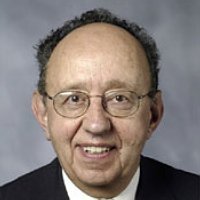Morton H. Friedman, Emeritus Professor

Dr. Friedman's research interests focus on the role of mechanical forces in the localization and evolution of vascular disease, particularly atherosclerosis. Specific areas of research are the influence of adaptation on vascular biology and physiology, the influence of shear stress gradients and harmonic content on the vascular endothelium, and the influence of coronary artery geometry and dynamics on plaque formation and rupture.
The first of these explores the effect of changes in blood flow on the permeability of the arterial wall to large molecules, and the expression and distribution of proteins that might mediate the permeability response. Our interest in permeability is motivated by the fact that a key initial step in the development of atherosclerosis is the accumulation of cholesterol-carrying lipoproteins in the vessel wall. In many areas of the vasculature, the blood flow changes during the day, as, for instance, during digestion or exercise. Our hypothesis is that these changes cause transient increases in permeability, and that it is during these transients, while the wall is adapting to its new fluid dynamic environment, that most of the uptake of fats by the wall takes place. The hypothesis is tested in animal experiments using swine.
A related study seeks a better understanding of the influence of fluid dynamic stresses on the vessel wall in the normal adapted state. Of particular interest are the effects of shear stress gradients and the high frequency components of the shear stress profile at a site. The effect of these variables are examined in the swine experiments noted above, and in custom designed flow systems that expose cultured endothelial cells to defined shear stress environments. Research opportunities in these two studies, in addition to the experiments themselves, include calculation of the flow field and wall shear stress distributions generated experimentally, and measurement of the response of the vascular endothelium at the tissue (permeability – in vivo experiments only), cellular (junctions, cytoskeleton) and molecular (gene expression, RNA, protein) levels.
A second focus of Dr. Friedman’s laboratory explores the relationship between blood vessel geometry and dynamics and the natural history of atherosclerotic disease in the coronary arteries. Our interest in this area arises because of increasing evidence that wall mechanical forces play a role in the progression of atherosclerosis and its fatal consequences. The coronary arteries are tethered to the surface of the heart and deform as the heart beats. Since vascular geometry, such as the angle at an arterial branch, and vascular deformation, such as the flexing of an arterial bend, influence the wall stress distribution in the vessel, it follows that certain geometric or dynamic features of an individual's arteries might affect that person's susceptibility to disease. This hypothesis is being tested using both clinical data and studies in genetically modified mice that develop humanoid atherosclerosis in a matter of weeks. Research opportunities include the analysis of coronary artery images obtained using cineangiography (human), stereomicroscopy (mouse) and intravascular ultrasound (human), mechanical modeling of the vascular wall to elucidate the relation between vessel dynamics and plaque rupture, and proteomic and genomic studies on the mouse tissues.
Note: the most current description of Dr. Friedman's research and listing of recent publications with links can be found at the Cardiovascular Simulations Laboratory website, whose URL is given below.
| Office Location: | 1427 Fciemas |
| Office Phone: | (919) 660-5131 |
| Email Address: |  
|
| Web Pages: |
http://www.bme.duke.edu/personal/friedman/home.html Friedman Web page http://biotrans.pratt.duke.edu Book: Principles and Models of Biological Transport |
- Education:
- PhD, University of Michigan, 1961
- MSE, University of Michigan, 1958
- BSE, Cornell University, 1957
- MSE, University of Michigan, 1958
- Research Interests:
Dr. Friedman's research interests focus on the role of mechanical forces in the localization and evolution of vascular disease, particularly atherosclerosis. Specific areas of research are the influence of adaptation on vascular biology and physiology, the influence of shear stress gradients and harmonic content on the vascular endothelium, and the influence of coronary artery geometry and dynamics on plaque formation and rupture.
- Specialties:
-
Atherosclerosis
Hemodynamics
Biological Transport
Mathematical Modeling
Angiographic and Ultrasound Image Processing
Computational Fluid Dynamics
- Awards, Honors, and Distinctions
Dedicated Service Award, American Society of Mechanical Engineers
Distinguished Service Award, AIMBE
Elected Member, World Council of Biomechanics
Fellow, American Association for the Advancement of Science
Fellow, American Heart Association, Council on Arteriosclerosis, Thrombosis & Vascular Biology
Fellow, American Society of Mechanical Engineers
Fellow, American Institute of Chemists
Founding Fellow, American Institute of Medical and Biological Engineering
H.R. Lissner Medal, American Society of Mechanical Engineers
Inaugural Fellow, Biomedical Engineering Society
National Capital Award, District of Columbia Council of Engineering and Architectural Societies
Richard Skalak Best Paper Award, American Society of Mechanical Engineers, Journal of Biomedical Engineering, 2006
- Recent Publications
(More Publications)
- G. A. Ateshian and M. H. Friedman, Integrative biomechanics: A paradigm for clinical applications of fundamental mechanics, Journal Of Biomechanics, vol. 42 no. 10 (July, 2009), pp. 1444 -- 1451 [abs].
- H. Zhu and Z. H. Ding and R. N. Piana and T. R. Gehrig and M. H. Friedman, Cataloguing the geometry of the human coronary arteries: A potential tool for predicting risk of coronary artery disease, International Journal Of Cardiology, vol. 135 no. 1 (June, 2009), pp. 43 -- 52 [abs].
- M. H. Friedman, Variability of arterial wall shear stress, its dependence on vessel diameter and implications for Murray's Law, Atherosclerosis, vol. 204 no. 1 (May, 2009), pp. 18 -- 19 .
- M. H. Friedman, Variability of arterial wall shear stress, its dependence on vessel diameter and implications for Murray's Law, Atherosclerosis, vol. 203 no. 1 (March, 2009), pp. 47 -- 48 .
- Y. Liang and H. Zhu and M. H. Friedman, Estimation of the transverse strain tensor in the arterial wall using ivus image registration, Ultrasound In Medicine And Biology, vol. 34 no. 11 (November, 2008), pp. 1832 -- 1845 [abs].